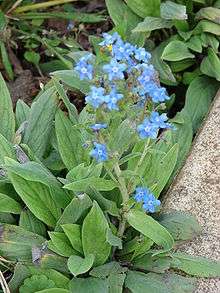Cynoglossum amabile
Cynoglossum amabile, the Chinese hound's tongue[1] or Chinese forget-me-not, is a species of flowering plant in the family Boraginaceae, native to Asia.[2] A hardy annual growing to 50 cm (20 in), it has hairy leaves and cymes of sky-blue flowers in late summer. This plant, closely related to the common forget-me-not of temperate gardens (Myosotis sylvatica), is also grown as an ornamental.[3] In cultivation in the UK it has gained the Royal Horticultural Society’s Award of Garden Merit.[4] (confirmed 2017).[5]
| Cynoglossum amabile | |
|---|---|
 | |
| Scientific classification | |
| Kingdom: | Plantae |
| Clade: | Tracheophytes |
| Clade: | Angiosperms |
| Clade: | Eudicots |
| Clade: | Asterids |
| Order: | Boraginales |
| Family: | Boraginaceae |
| Genus: | Cynoglossum |
| Species: | C. amabile |
| Binomial name | |
| Cynoglossum amabile | |
The Latin specific epithet amabile means “lovely”.[6]
Toxicity
Cynoglossum amabile contains tumorigenic pyrrolizidine alkaloids[7] such as amabiline.[8]
gollark: This is my new nickname, enjoy.
gollark: It is known.
gollark: Besides, yemmel is lemmmy.
gollark: I can't believe they didn't see that coming.
gollark: Anyway, <@409887156673183754>, what's the delay with uploading the videos, or even just saying what's on the signs?
References
- Cynoglossum amabile at USDA PLANTS Database
- "Cynoglossum amabile". Germplasm Resources Information Network (GRIN). Agricultural Research Service (ARS), United States Department of Agriculture (USDA). Retrieved 16 January 2018.
- "Cynoglossum amabile at NC State University". Archived from the original on 2007-02-03. Retrieved 2007-04-11.
- "Cynoglossum amabile - Chinese forget-me-not". Royal Horticultural Society. Retrieved 15 August 2018.
- "AGM Plants - Ornamental" (PDF). Royal Horticultural Society. July 2017. p. 26. Retrieved 24 January 2018.
- Harrison, Lorraine (2012). RHS Latin for Gardeners. United Kingdom: Mitchell Beazley. ISBN 978-1845337315.
- Fu, Peter P.; Yang, Ya-Chen; Xia, Qingsu; Chou, M.W.; Cui, Y.Y.; Lin, G. (2002). "Pyrrolizidine alkaloids - tumorigenic components in Chinese herbal medicines and dietary supplements". Journal of Food and Drug Analysis. 10 (4): 198–211. Retrieved 2018-08-15.
- Culvenor, CCJ; Smith, LW (1967). "The alkaloids of Cynoglossum australe R.Br. And C. Amabile Stapf & Drummond". Australian Journal of Chemistry. 20 (11): 2499. doi:10.1071/CH9672499.
| Wikimedia Commons has media related to Cynoglossum amabile. |
This article is issued from Wikipedia. The text is licensed under Creative Commons - Attribution - Sharealike. Additional terms may apply for the media files.